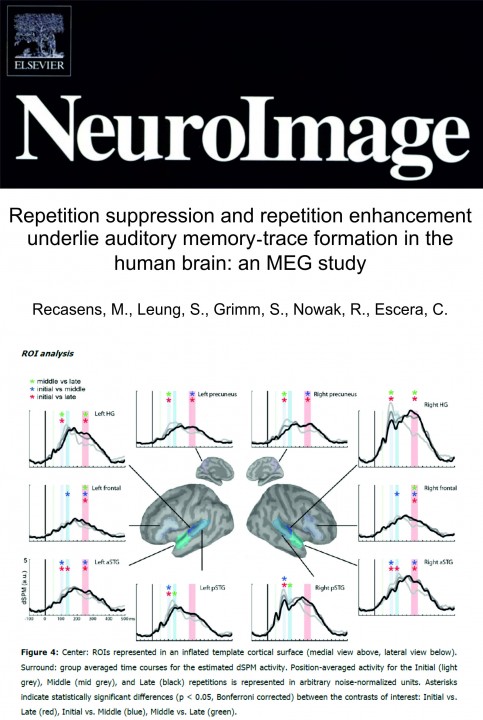The paper entitled Repetition suppression and repetition enhancement underlie auditory memory‐trace formation in the human brain: an MEG study, by Recasens, Leung, Grimm, Nowak, and Escera, has been accepted for publication in Neuroimage.
In this study, we showed that auditory sensory memory trace formation encompassed both repetition suppression and repetition enhancement. Suppression occurred by the time range of the auditory N1 and involved a widely distributed network including temporal and parietal brain regions. Enhancement occurred in later time ranges, circa 230-270 ms in more anterior temporo-insular regions, and overlapping frontal and parietal cortices.
The full abstract is as follows:
The formation of echoic memory traces has traditionally been inferred from the enhanced responses to its deviations. The mismatch negativity (MMN), an auditory event-related potential (ERP) elicited between 100 and 250 after sound deviation is an indirect index of regularity encoding that reflects a memory-based comparison process. Recently, repetition positivity (RP) has been described as candidate ERP correlate of direct memory trace formation. RP consists of repetition suppression and enhancement effects occurring in different auditory components between 50 and 250 ms after sound onset. However, the neuronal generators engaged in the encoding of new stimulus features have received little interest. This study intends to investigate the neuronal sources underlying the formation and strengthening of new memory traces by employing a roving-standard paradigm, where trains of different frequencies and different durations are presented randomly. Source generators of repetition enhanced (RE) and suppressed (RS) activity were modeled using magnetoencephalography (MEG) in healthy subjects. Our results show that, in line with RP findings, N1 (~95–150 ms) activity is suppressed with stimulus repetition. In addition, we observed the emergence of a sustained field (~230–270 ms) that showed RE. Source analysis revealed neuronal generators of RS and RE located in both auditory and non-auditory areas, like the medial parietal cortex and frontal areas. The different timing and location of neural generators involved in RS and RE points to the existence of functionally separated mechanisms devoted to acoustic memory-trace formation in different auditory processing stages of the human brain.


